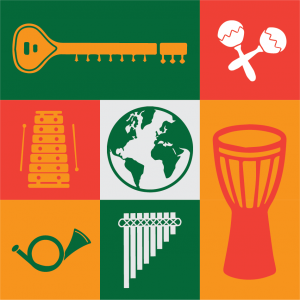Music of West Asia: Maqam

Overview
The majority of traditional music in West Asia and North Africa is based on a modal system and melody type called maqam. Regional, cultural and functional variations of this system can be subtle to substantial. From its roots in the Arabic language, maqam appears in Arab music and is a system for composing and improvising from diverse groups including Iraqis, Turks, and Persians, among others. Maqams are used in secular and sacred art music, including Islamic rites such as Quran recitation and Sufi devotional ceremonies, as well as popular music traditions. The repertory has been preserved in an aural tradition for centuries and has strong connections between music and poetry. The music can be played solo, in ensembles, as instrumental music, vocal music, or both. As a melodic system, traditional music does not include harmony.
Musician
Rob Simms, PhD
Rob Simms is an ethnomusicologist and multi-instrumentalist specializing in Middle Eastern and West African traditions. He plays setar (long-necked lute), ney (reed flute), ‘oud (short-necked lute), kora (harp), guitar, and various percussion instruments. His research interests include maqam repertoires, Mande music (West Africa), improvisation and creative processes. Rob is an Associate Professor in the Department of Music at York University in Toronto, Ontario.
Terminology
An understanding of the following terms would be helpful before proceeding with the Video Content.
- Maqam
- Rhythmic mode
- ‘Oud
- Ney
- Tarab
- Taqsim
- Sama
Video Content
Rob provides a demonstration of the ‘oud (fretless lute) and ney (upright flute) while playing and discussing a variety of maqams used in West Asian art music. Some music theory is covered to explain and demonstrate the musical construction of maqams, relationships between them, the performance of composed music, and improvised pieces called taqsim. Ideas about composition and improvisation are developed, along with musical transmission, while the discussion often returns to concerns of musical meaning, and how the sound is related to feeling, communication, and symbolism with regard to Sufism, Quran recitation, and poetry.
Transcript: Music of West Asia
Video Time Cues
- 0:06 Self introduction
- 1:33 Description and demonstration of the ‘oud
- 6:25 Microtones on the fretless neck
- 9:28 Microtones, maqam, Sufism and tarab
- 15:05 Demonstration of Rast and the power of music
- 16:50 Demonstration of maqam Saba
- 18:32 Maqam, feeling, and communication
- 21:47 Cultural exchange in Turkish, Arab, Persian music
- 23:08 Learning maqam and playing/performance settings
- 30:08 Diversity and relationships between maqams
- 34:26 Significance of Rast, Bayati, and Quran recitation
- 37:53 Demonstration of maqam Bayati
- 39:52 Improvisation, taqsim, and types of compositions
- 45:13 Classical composition in Bayati/rhythmic modes
- 49:36 Taqsim as a prelude, and heterophony
- 51:58 Performance after a taqsim & audience interaction
- 57:05 The ney, cultural context, sama and poetry by Rumi
- 1:03:59 Maqam Rast on the ney and symbolism of the ney
- 1:06:58 Learning the ney, breath and overtones
- 1:13:38 Breathy sound as connected to Sufism
- 1:16:22 Demonstration of maqam Hijaz
- 1:18:25 Demonstration of maqam Segah
- 1:21:56 Improvisation and “personalities” of maqam
- 1:24:07 Demonstration of maqam Ussak compared with Bayati
- 1:26:40 Maqam Husseini & performance practice on the ney
- 1:30:45 Maqam Husseini and comparison to Bayati
- 1:32:03 Demonstration of maqam Segah with a drone
- 1:35:00 Playing maqam as a Canadian/relating through music
Suggested Activities and Assessments
Terms
Create a limited-access wiki of the terms and their definitions listed in the Terminology section above. Students can work individually to create their own “wiki” as text files, or in teams (e.g., through a course website). Students research the meanings, and if relevant, the history of these terms.
Participation
- Following rhythmic modes
A commonly used 10-beat rhythmic mode is demonstrated through syllables of “dum” and “tak” followed by a performance on ‘oud (see the Video Time Cues section above). Have students repeat the syllables “dum” and “tak” with Rob in the video to learn the mode, then continue to say the syllables during the performance to follow the cycle. - Singing microtones
Some maqams include 3/4 tones (microtones). Rob demonstrates Rast a number of times, including an ascending scale in “demonstration of maqam Bayati” (see the Video Time Cues section above). Have students sing the notes of Rast using solfège syllables. Although this doesn’t include any melodic practice of how Rast is performed, singing microtones helps students become more accustomed to their sound, and the ability to distinguish different maqams.
| Solfège syllable: | Do | Re | Mi | Fa | Sol | La | Ti | Do | ||||||||
|---|---|---|---|---|---|---|---|---|---|---|---|---|---|---|---|---|
| Notes: | C | D | E-hf | F | G | A | B-hf | C | ||||||||
| Interval in tones | 1 | ¾ | ¾ | 1 | 1 | ¾ | ¾ | |||||||||
- Quiz: Game show
Microtones or not? What maqam is this?
Instructors play demonstrations of maqams or other modes with and without microtones (some included in the Video Time Cues section above), and students identify if the mode has microtones or not. If so, which maqam is it, and how did you arrive at that decision? - Debate
The conclusion of the video raises ideas about universals in music. To what extent can we relate to cultures other than our own through music?
Research
Assign small groups to contribute to a document for researching the use, function, and performance settings of maqams in West Asia and North Africa. Topics may include Quran recitation, sama, taqsim, classical music, popular music, and more. Students are encouraged to include if the music is composed or improvised, metric or in free rhythm, which maqams are commonly used, and extended discussion of the music’s social function.
